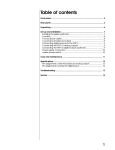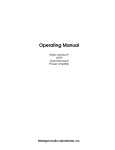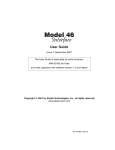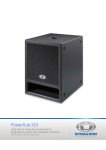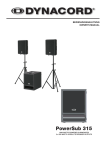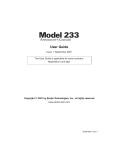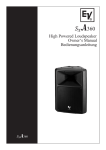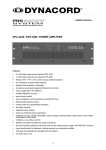Download Madrigal Audio Laboratories Proceed Specifications
Transcript
Table of contents About Compact Disc Digital Audio… ....................................................... 2 Front panel ................................................................................................... 3 Display .......................................................................................................... 6 Remote Control ........................................................................................... 7 Rear panel, PCD 3 ....................................................................................... 8 Rear panel, PDT 3 ...................................................................................... 10 Unpacking ................................................................................................. 12 Set-up and installation .............................................................................. 13 Installing the spikes (optional) ................................................................ 13 Removing the transport screws ............................................................. 14 Location .................................................................................................... 15 A word about cables .............................................................................. 15 A word about balanced output ........................................................... 15 Audio connections, PCD 3 ..................................................................... 15 Audio connections, PDT 3 ...................................................................... 16 Power supply connection ...................................................................... 16 master power switch ............................................................................... 16 Installing batteries in the Remote Control ............................................ 16 Basic operation ......................................................................................... 17 Loading a CD .......................................................................................... 17 Playing all tracks on a CD ...................................................................... 17 Beginning play with a track other than the first track ......................... 17 Replaying a track .................................................................................... 18 Skipping to another track ....................................................................... 18 Searching for a passage on the CD ..................................................... 18 Beginning play in the middle of a track ............................................... 18 The "pause" function ............................................................................... 19 Repeating all tracks on the CD ............................................................. 19 Stopping play ........................................................................................... 19 Programming ............................................................................................. 20 Entering a program ................................................................................. 20 Replaying a selection in the program .................................................. 20 Skipping to another selection in the program ..................................... 21 Searching for a passage in the program ............................................. 21 The "pause" function ............................................................................... 21 Repeating all tracks in a program ......................................................... 21 Stopping play ........................................................................................... 21 Care and maintenance ........................................................................... 22 Cleaning the PCD 3/PDT 3 ..................................................................... 22 Caring for the Remote Control .............................................................. 22 Caring for Compact Discs ...................................................................... 22 Specifications, PCD 3 ................................................................................ 23 Pin assignments, male XLR balanced analog output ......................... 23 Specifications, PDT 3 ................................................................................. 24 Pin assignments, male XLR digital output ............................................. 24 Troubleshooting ......................................................................................... 25 Service ....................................................................................................... 27 1 About Compact Disc Digital Audio… To most people, a Compact Disc (CD) looks like a small, silver phonograph record. In fact, there are some important differences between records and CDs. The information on a phonograph record is contained within its grooves. This analog information is read by a stylus riding along in the grooves and transmitted via a cartridge. The digital information on a CD, though arranged in similar grooves, is read by a laser mechanism (called a pickup). A phonograph's stylus Direction the disc rotates must be in contact with the record, but a CD player's pickup never Track 3 touches the CD. The information Track 2 on the CD is transmitted via complex decoder circuitry. rack 1 T The CD rotates counterclockwise, and the laser pickup reads the underside of the CD (the side opposite the label) beginning at the center and travelling toward the outer edge. As the pickup moves away from the center, the speed of rotation gradually decreases from 500 to 200 revolutions per minute. Direction the laser pickup travels Programs on CDs are organized into tracks, usually corresponding to songs or movements. This allows the user to easily and precisely select a part of a program with virtually no wear and tear on the CD. There may be as many as 99 tracks on a Lindsay's First Symphony CD. First Movement Second Movement Third Movement On some CDs, tracks are further broken down into Index Numbers from Track 2 indexes. These 01 02 03 04 05 06 94 95 96 97 98 99 "tracks within tracks" allow even more precise selection and programming. A single track may have up to 99 indexes. (Track 1) 2 (Track 2) (Track 3) Front panel 15 9 TRACK INDEX MIN 8 SEC 7 stop play 12 pause prev progm repeat prev index next 3 2 6 next index 4 5 11 10 error 14 drawer 17 13 standby 16 1 1 standby When the master power switch on the rear panel is in the "|" (on) position, pressing this button takes the PCD 3/PDT 3 out of “standby” mode, turns the Display on, and makes the PCD 3/PDT 3 ready to play a CD. Pressing the button again puts the PCD 3/PDT 3 in standby mode and clears any previously programmed sequence of selections. (See "Rear panel" and "Setup and installation.") 2 play After a CD is loaded into the drawer, pressing this button begins play with the first track on the CD (or the first track in a programmed sequence). If you press play while the drawer is open, the drawer closes and play starts beginning with the first track on the CD. Pressing play while a CD is playing suspends play, returns to the beginning of the current track, and replays that track. 3 stop Pressing this button while a CD is playing stops play and clears any previously programmed sequence of selections. Pressing play after pressing stop begins play again with the first track on the CD. 3 4 pause While a CD is playing, pressing this button suspends play; pressing it again resumes play at the point where pause was first pressed. The LED above the pause button lights while play is suspended. 5 next Pressing this button while a CD is playing suspends play, “skips” to the next track on the CD (or the next track in a programmed sequence), and begins playing that track. Pressing next before play begins skips to the beginning of the next track; pressing play begins playing that track. 6 prev Like the next button, pressing prev while a CD is playing suspends play, “skips” to the previous track on the CD (or the previous track in a programmed sequence), and begins playing that track. Pressing prev before play begins skips to the beginning of the previous track; pressing play begins playing that track. 7 progm Pressing this button after making a selection (using next, prev, next index, prev index, or the numbered buttons on the Remote Control) enters it as part of a programmed sequence. (See "Programming.") The LED above the progm button will flash while you assemble a program. This LED will remain lighted after an entry is made and while a sequence is playing. 8 >> Holding this button down during play moves the laser pickup toward the end of the CD. During search, the pickup moves at three different speeds, increasing in speed the longer you hold down the >> button. At the first two search speeds, the volume is reduced; at the fastest search speed, the volume is muted completely. When you release >>, play resumes. 9 << This button works in the same way as >>, except that it moves the laser pickup toward the beginning of the CD. 10 next index If the CD in play has indexes, pressing this button skips the laser pickup to the next index on the CD, and the index number on the Display will increase. (See "Display.") 11 prev index This button works in the same way as next index, except that it moves the laser pickup toward the beginning of the CD. 4 12 repeat Pressing this button before or during play causes all tracks on the CD (or all selections in a programmed sequence) to repeat indefinitely. To cancel this function, press repeat again. The LED above the repeat button lights while the repeat function is active. 13 drawer Pressing this button opens the drawer; pressing it again closes the drawer. Pressing drawer while a CD is playing stops play, clears any previously programmed sequence of selections, and opens the drawer. PRECAUTION NEVER hold onto the drawer while it's in motion (either opening or closing). If you accidentally prevent the drawer from opening, wait about three seconds, then press drawer twice to open it. If you accidentally prevent the drawer from closing, it will open again after about three seconds. Press drawer again to close it. 14 error This LED will light when a function is entered incorrectly. 15 Display This window displays information about track, index, and elapsed time. (See "Display.") 16 Remote sensor window This window receives the infrared signals from the Remote Control, allowing remote operation. Make sure that this window is not blocked. (See "Remote Control.") 17 Drawer The drawer contains the tray that holds the CD during play. Its operation is controlled by the drawer button. 5 Display 1 1 2 3 TRACK INDEX MIN SEC TRACK Before play begins, this part of the Display shows the total number of tracks on the CD. During play, this part of the Display shows the number of the track in play. While play is suspended using pause, it shows the track that was playing when play was suspended. 2 INDEX Before play, this part of the Display is blank. If the CD in play has indexes, this part of the Display shows the index on the CD beginning with “01” and increasing as the CD plays. If the CD in play has no indexes, this part of the Display shows “01” throughout play. 3 MIN SEC Before play, this part of the Display shows the total time for all tracks on the CD. During play, this part of the Display shows the elapsed time for the track in play. After you enter a selection into the memory (as part of a program), the MIN part of the Display shows "P." (See "Programming.") TRACK 6 INDEX Remote Control 11 5 PREV NEXT PLAY 1 STOP/CM 4 2 << >> PAUSE 7 3 8 1 2 3 4 5 6 7 8 9 0 PROGR 10 6 REPEAT 9 1 2 3 4 5 PLAY 6 PROGR STOP/CM (STOP) 7 << PAUSE 8 >> NEXT 9 REPEAT PREV Each of these buttons (1 – 9) performs the same function as its counterpart on the front panel. (See “Front panel.”) 10 Numbered buttons These buttons may be used to select tracks when programming a sequence of tracks. The numbered buttons may also be used to select a particular track (instead of using the NEXT or PREV buttons). Pressing a track number before play, the pressing PLAY, begins play with that track and continues playing tracks on the CD in order. Pressing a track number during play, then pressing PLAY, skips to that track and begins play, then continues playing tracks on the CD in order. 11 Projection lens Infrared (IR) commands from the Remote Control to the PCD 3/PDT 3 are transmitted through this lens. 7 Rear panel, PCD 3 2 3 3 unbalanced unbalanced balanced balanced right-channel output MADRIGAL AUDIO LABORATORIES, INC. PROCEED® COMPACT DISC PLAYER WARNING: TO REDUCE THE RISK OF FIRE OR ELECTRIC SHOCK, DO NOT EXPOSE THIS APPLIANCE TO RAIN OR MOISTURE. CAUTION RISK OF ELECTRIC SHOCK DO NOT OPEN MODEL NO: CAUTION: TO REDUCE THE RISK OF ELECTRICAL SHOCK, DO NOT REMOVE COVER. NO USERSERVICEABLE PARTS INSIDE. REFER SERVICING TO QUALIFIED PERSONNEL. SERIAL NO: MANUFACTURED: 50-60 HZ 25 WATTS left-channel output VOLTS CAUTION: FOR CONTINUED PROTECTION AGAINST RISK OF FIRE, REPLACE ONLY WITH THE SAME TYPE OF FUSE: A, 250V 4 PROCEED® PCD 3 made in u.s.a. 6 5 digital output master power 1 1 NEVER operate the master power switch without first making sure that power is turned off to your receiver, integrated amplifier, or preamplifier/power amplifier. PRECAUTION 8 master power This switch turns the PCD 3 on and off. The switch must be in the "|" (on) position for the PCD 3 to operate. (See "Set-up and installation.") 2 unbalanced outputs These outputs provide single-ended analog audio (via cables equipped with RCA-type connectors) to a receiver, integrated amplifier, or preamplifier equipped with single-ended inputs. Most components accept this type of output. (See "Set-up and installation.") 3 balanced outputs These outputs provide balanced analog audio (via cables equipped with XLR-type connectors) to a preamplifier, integrated amplifier, or receiver equipped with balanced inputs. (See "Set-up and installation.") 4 RCA (SPDIF) digital output This output provides digital audio (via a cable equipped with RCAtype connectors) to the digital input of a receiver, integrated amplifier, preamplifier, or digital processor. (See "Set-up and installation.") 5 AC power cord This cord supplies AC power to the PCD 3. (See "Set-up and installation.") 6 Fuse This holder contains the main fuse for the PCD 3. If the fuse ever needs to be replaced, contact your Proceed dealer. 9 Rear panel, PDT 3 spdif aes/ebu st eiaj 2 3 4 5 digital outputs WARNING: TO REDUCE THE RISK OF FIRE OR ELECTRIC MADRIGAL AUDIO LABORATORIES, INC. SHOCK, DO NOT EXPOSE THIS APPLIANCE TO RAIN OR MOISTURE. PROCEED® COMPACT DISC PLAYER CAUTION RISK OF ELECTRIC SHOCK DO NOT OPEN MODEL NO: CAUTION: TO REDUCE THE RISK OF ELECTRICAL SHOCK, DO NOT REMOVE COVER. NO USERSERVICEABLE PARTS INSIDE. REFER SERVICING TO QUALIFIED PERSONNEL. SERIAL NO: MANUFACTURED: 7 CAUTION: FOR CONTINUED 50-60 HZ 25 WATTS PROCEED® PDT 3 made in u.s.a. VOLTS PROTECTION AGAINST RISK OF FIRE, REPLACE ONLY WITH THE SAME TYPE OF FUSE: A, 250V master power 6 1 1 PRECAUTION 10 master power This switch turns the PDT 3 on and off. The switch must be in the "|" (on) position for the PDT 3 to function. (See "Set-up and installation.") NEVER operate the master power switch without first making sure that power is turned off to your receiver, integrated amplifier, or preamplifier/power amplifier. 2 spdif (RCA) digital output This output provides digital audio (via a cable equipped with RCAtype connectors) to the digital input of a receiver, integrated amplifier, preamplifier, or digital processor. (See "Set-up and installation.") 3 aes/ebu (XLR) digital output This output provides digital audio (via a cable equipped with XLRtype connectors) to the digital input of a receiver, integrated amplifier, preamplifier, or digital processor. (See "Set-up and installation.") 4 st (AT&T) digital output This output provides digital audio (via an optical cable equipped with ST-type connectors) to the optical digital input of a receiver, integrated amplifier, preamplifier, or digital processor. (See "Set-up and installation.") 5 eiaj (TOSLINK) digital output This output provides digital audio (via an optical cable equipped with TOSLINK-type connectors) to the optical digital input of a receiver, integrated amplifier, preamplifier, or digital processor. (See "Set-up and installation.") 6 AC power cord This cord supplies AC power to the PDT 3. (See "Set-up and installation.") 7 Fuse This holder contains the main fuse for the PDT 3. If the fuse ever needs to be replaced, contact your Proceed dealer. 11 Unpacking Carefully open the shipping carton and remove the contents. You should have: ■ ■ ■ ■ ■ Proceed PCD 3/PDT 3 Four spikes Hex key Remote control Owner’s manual Save the shipping carton and all packing material. Though it may be inconvenient to store, it’ll come in handy for shipping if you move, or if the unit needs to be shipped for service. Locate the serial number (on the back panel), and record it here: ■ Serial Number: Keep your sales receipt where you can find it. You’ll need to show it for any service during the warranty period. Take a moment now to record some information from the receipt: ■ Date of purchase: ■ Proceed dealer: ■ Dealer’s address: ■ Dealer’s telephone number: 12 Set-up and installation To set up your Proceed PCD 3/PDT 3, you’ll need: ■ ■ ■ ■ ■ A soft cloth or towel (step 2) A flat-bladed (standard) screwdriver (step 5) A pair of audio cables (step 9), or A single audio cable (step 10 or 11) Three AAA batteries (step 16) 1. Make sure that the unit is unplugged from the AC power supply and disconnected from your receiver, integrated amplifier, or preamplifier. 2. Place the unit upright on a flat, stable surface. Carefully tip it so it rests on its side; protect its finish with a soft cloth. Installing the spikes (optional) 3. The PCD 3/PDT 3 is shipped so that it rests solidly on two wide "feet," positioned under the front and back of the unit. You may want to explore the potential sonic advantages of installing the specially designed "spikes" supplied with the unit. One arrangement is to install the spikes under the corners of the unit: Four spikes, mounted at the corners 13 You may choose instead to install the spikes in a triangular arrangement: Three spikes, mounted in a triangular pattern Install the spikes one at a time. Using the supplied hex key, remove the screw securing the foot to the base of the unit. Insert the threaded end of the spike through the hole in the foot, then turn it clockwise until it's hand-tight. (Be careful not to over-tighten it.) Repeat this procedure for each spike you install. Removing the transport screws 4. Locate the two transport screws on the bottom of the unit. Transport screws 5. Using a flat-bladed screwdriver, remove both transport screws (by turning them counterclockwise). 6. Save the transport screws with the packing material. If you ever need to ship the unit, you must replace these screws. 14 Location 7. Turn the unit upright, and place it in the desired location. The Proceed PCD 3/PDT 3 should be located on a level, stable surface. Avoid placing it where it will be exposed to shocks or vibration (such as on an unstable table or near large loudspeakers). In general, place it as you would a turntable. PRECAUTION DON'T place the Proceed PCD 3/PDT 3 on top of another component, since its base could block the other component’s ventilation. Interfering with the PCD 3/PDT 3’s ventilation or that of another component could cause either to overheat, resulting in damage to your system. 8. Before making any audio connections, make sure that power is turned off to both the PCD 3/PDT 3 and your receiver, integrated amplifier, or preamplifier/power amplifier. A word about cables A word about balanced output ■ The quality of the cables and connectors that you use with your Proceed Proceed PCD 3/PDT 3 can noticeably affect the quality of the sound that you hear from your speakers or headphones. For the best performance, use the highest quality audio cables available. Though there are many such cables to choose from, we confidently recommend Madrigal HPC cables (for analog signals) and Madrigal MDC (for electrical digital signals). See your Proceed dealer for more information. ■ The Proceed PCD 3 provides balanced analog output by way of standard three-pin XLR-type connectors. This provides the highest quality connection and, therefore, the best sound. Terminated with the proper connector, balanced input on an amplifier or power amplifier minimizes the chance of “coloration” of the sound due to cabling. If you’re unfamiliar with balanced interconnection and how it works with your audio system, see your Proceed dealer for more information. For instructions on connecting the PCD 3's balanced or unbalanced analog outputs to your audio system, see step 9. For instructions on connecting the PCD 3's digital output to your audio system, see step 10. For instructions on connecting the PDT 3's digital outputs to your audio system, see step 11. Audio connections, PCD 3 9. Using a pair of high-quality audio cables, connect the left and right outputs of the PCD 3 to the left and right “CD” inputs of your receiver, integrated amplifier, or preamplifier. Make sure to connect the left output of the PCD 3 to the left input of the receiver, integrated amplifier, or preamplifier, and likewise for the right channel. If your receiver, integrated amplifier, or preamplifier doesn’t have inputs specifically labelled “CD,” use the input labelled “AUX,” or any other line-level input not being used by another component. NEVER connect the PCD 3's balanced or unbalanced outputs to PHONO inputs. 15 Audio connections, PCD 3 10. Using a high-quality audio cable, connect the digital output of the PCD 3 to the digital input of your receiver, integrated amplifier, preamplifier, or digital processor. NEVER connect the PCD 3's digital output to PHONO inputs. Audio connections, PDT 3 11. Using a high-quality audio cable, connect the digital output of the PDT 3 to the digital input of your receiver, integrated amplifier, preamplifier, or digital processor. NEVER connect the PDT 3's digital output to PHONO inputs. Power supply connection 12. Connect the power supply cord of the PCD 3/PDT 3 to an unswitched convenience outlet (like those on the rear panel of many audio components). If you connect the PCD 3/PDT 3 directly to a wall outlet, make sure that the outlet has polarized sockets. master power switch 13. Set the master power switch on the rear panel to the "|" (on) position, and allow the PCD 3/PDT 3's circuitry to stabilize for several minutes before operating it. Note: The PCD 3/PDT 3 won't achieve its sonic potential right away — sonic performance is close to the optimum after 350 hours (or about two weeks of normal use). For the best performance, you may leave it powered at all times, except when you won't be using it for a long period (see "Important Safety Instructions"). The PCD 3/PDT 3 may be turned on and off without affecting its longevity. When it is turned on after being left unpowered, allow about one hour before expecting optimal sonic performance. 14. After making all connections and turning the master power switch on, turn on the other components in your system. PRECAUTION Installing batteries in the Remote Control NEVER operate the master power switch without first making sure that power is turned off to your receiver, integrated amplifier, or preamplifier/power amplifier. 15. Remove the cover of the Remote Control’s battery compartment by sliding it in the direction of the arrow. 16. Insert three AAA batteries according to the + and – symbols on the bottom of the battery compartment. Replace the battery compartment cover. 16 Basic operation In this section, you’ll learn how to: ■ ■ ■ ■ ■ ■ ■ ■ ■ ■ Loading a CD Load a CD; Play all tracks on a CD; Begin play with a track other than the first track; Replay a track; Skip to another track; Find a particular passage on the CD; Begin play in the middle of a track; Suspend play using pause; Repeat an entire CD; and Stop play. To load a CD for play: 1. Turn the power on by pressing standby. The Display will light and show " 0 0 0 00." 2. Press drawer to open the drawer. PRECAUTION NEVER hold onto the drawer while it’s in motion (either opening or closing). If you accidentally prevent the drawer from opening, wait about three seconds, then press drawer twice to open it. 3. Load a CD into the drawer, label side up. Handle the CD by the outer edges only; if necessary, support it with your index finger at the center hole. 4. Close the drawer by pressing drawer again. Note: If you accidentally prevent the drawer from closing, it will open again after about three seconds. Press drawer again to close it. In a few seconds, the Display will show the total number of tracks and their total playing time. The CD is now ready for play. Playing all tracks on a CD Beginning play with a track other than the first track To play all tracks on a CD, press play. All tracks will play in order. Play will stop automatically at the end of the CD. To begin play with a track other than the first track: 1. Before pressing play, press next until the number of the desired track shows on the Display. If you pass the track you want to play, you can “back up” by pressing prev. You may also select the track using the numbered buttons on the Remote Control. 17 2. Press play to begin playing that track (followed by the remaining tracks on the CD). Replaying a track To return to the beginning of a track while it is playing, press play. Play will be suspended briefly, then that track will replay followed by the remaining tracks on the CD. Skipping to another track You may skip to another track any time while a CD is playing. To move to another track, press next (to go forward) or prev (to go backward) until the number of the track you want to play shows on the Display. (You may also select the track using the numbered buttons on the Remote Control.) Play will resume as soon as the pickup reaches that track. Searching for a passage on the CD You may search for a particular passage on the CD using >> and <<. Scan the CD until the laser pickup reaches the passage you want to hear. (If a CD has indexes, you may also press next index and use the index numbers on the Display as a guide.) Remember that the search speed increases the longer you hold down >> or <<. As soon as you release the button, play resumes. If you scan past the beginning or end of a track, the laser pickup will move on to the previous (or next) track (unless a programmed sequence is playing — see “Programming”). If you try to scan forward past the end of the CD, the laser pickup will stop five seconds before the end of the last track and the error LED will flash. When you release >>, play will continue with the last track. If you try to scan backward past the beginning of the CD, the laser pickup will stop at the beginning of the first track and the error LED will flash. When you release <<, the CD will play beginning with the first track. Beginning play in the middle of a track If a CD has indexes, you may begin play in the middle of a track: 1. Using next and prev (or using the numbered buttons on the Remote Control), select a track number. 2. Press next index to move forward to the point in the track where you want to begin play. Hold the button down to go forward quickly; press and release it to go forward slowly. 3. Press play to begin play at the index you selected. 18 The "pause" function To suspend play while a CD is playing, press pause. The LED above the pause button will light while play is suspended. To resume play, press pause again. To hold play at the beginning of a CD or track (for faster cueing), press pause before pressing play. The LED above the pause button will light while play is suspended. To begin play, press pause again. (You may also select another track or index while play is suspended.) Repeating all tracks on the CD To repeat all tracks on a CD, press repeat before play or while a CD is playing. The LED above the repeat button will light while this function is active. The CD will continue to repeat until you press repeat again or press stop. Stopping play To stop play before the end of the CD, press stop. The Display will show the total number of tracks and their total playing time. You may also stop play by pressing drawer. In this case, play will stop and the drawer will open. 19 Programming In “Basic operation,” you learned how to play tracks as ordered on the CD. In this section, you’ll learn how to: ■ Enter and play a program of up to twenty tracks or indexes, in any order; ■ Play a program; ■ Replay a selection; ■ Skip to another selection in a program; ■ Find a particular passage in the program; ■ Suspend play using the “pause” function; ■ Repeat an entire program; ■ Stop play; and ■ Erase the memory. Rather than playing an entire CD, you may choose to play only certain selections. To do this, you'll need to create a “program” and store it in the PCD 3/PDT 3's memory. The memory will accept up to twenty entries. Entering a program is possible only before play begins. Entering a program To enter a program: 1. Load a CD into the drawer, and wait for the Display to show the total number of tracks and their total playing time. (See “Basic operation.") 2. Select the first track or index in your program using the next, prev, next index, and prev index, or the numbered buttons on the Remote Control. (See “Basic operation.") The LED above the progm button will flash while you're making your selection. 3. Enter your selection into memory by pressing progm. The LED above the progm button will light and the Display will show "P." Note: You must press progm within five seconds after making a selection, or the selection won’t be entered into the memory. 4. Select and enter the rest of the program (up to twenty selections) by repeating steps 2 and 3, making sure to press progm after each selection. 5. To begin playing the program, press play. The LED above the progm button will light and the "P" will disappear from the Display. Replaying a selection in the program 20 To return to the beginning of a selection while it is playing, press play. Play will be suspended briefly, then that selection will replay followed by the rest of the selections in the program. Skipping to another selection in the program next and prev function in the normal way, except that they move forward and backward among the selections in the program. Tracks that aren’t included in the program are skipped. If you use the numbered buttons on the Remote Control to select a track that isn’t part of the current program, the error LED will flash. Searching for a passage in the program You may search for a particular passage in the program using the >> and << buttons. Scan the program until the laser pickup reaches the passage you want to hear. Remember that the search speed increases the longer you hold down >> or <<. As soon as you release the button, play resumes. If you try to scan forward past the end of a selection, the laser pickup will stop five seconds before the end of the track, the error LED will flash. When you release the >> button, the program will continue. If you scan past the beginning of a selection, the laser pickup will stop at the beginning of the track and the error LED will flash. When you release <<, the program will continue. The "pause" function To suspend play while a program is playing, press pause. The LED above the pause button will flash while play is suspended. To resume play, press pause again. To hold play at the beginning of a program (for faster cueing), press pause before pressing play. The LED above the pause button will flash while play is suspended. To begin play, press pause again. Repeating all tracks in a program Stopping play To repeat all selections in a program, press repeat while the program is playing. The LED above the repeat button will light while this function is active. The program will continue to repeat until you press repeat again or press stop. To stop play before the end of the program, press stop. Pressing stop erases the program from the memory. (If the program is allowed to finish, it is retained in the memory.) You may also stop play by pressing drawer. In this case, play will stop, the program is erased from the memory, and the drawer will open. To suspend play while a program is playing without erasing the program from the memory, press pause. 21 Care and maintenance Cleaning the PCD 3/PDT 3 To clean your PCD 3/PDT 3, use a soft cloth moistened with plain water. Don’t apply water, dusting sprays, solvents, abrasives, or cleaning fluids directly to the cabinet. Make sure that the remote sensor window on the front panel of the unit and the Remote Control’s projection lens are kept clean and dustfree. Caring for the Remote Control Fluorescent lighting in the listening area may interfere with the operation of the Remote Control. Avoid placing the PCD 3/PDT 3 near fluorescent lamps. When the Remote Control’s batteries need to be replaced, use only 1.5V AAA batteries; always replace all three batteries at the same time. If you don’t plan to use the Remote Control often, remove the batteries. When not used for an extended period, even “leak-proof” batteries can leak corrosive acids that will damage the Remote Control. Caring for Compact Discs A CD, handled carefully, will last indefinitely. A warped, dusty, or scratched CD can cause playback problems or may sound noisy. Handle a CD by the outer edges only; if necessary, support it with your index finger at the center hole. Don’t touch the bottom (unprinted) side of the CD, and never apply stickers or labels to either side of the CD. If a CD becomes dirty, use a silicone-treated cloth (like those made for cleaning camera lenses) or a special CD cleaning kit. Don’t use solvents, anti-static fluids, or cleaners made for cleaning phonograph records. When you’re finished playing a CD, always return it to its plastic case. Store your CDs where they won’t be exposed to direct sunlight, high humidity, or extremely high or low temperatures. 22 Specifications, PCD 3 ■ ■ ■ ■ ■ ■ ■ ■ ■ ■ ■ ■ ■ Frequency response: 10 Hz – 20 kHz +0dB, -0.2dB Total harmonic distortion (THD): 0.004% @ 1 kHz, 0dB Dynamic range: 104dB (or better) Signal-to-noise ratio: 107dB Channel separation: 120dB Intermodulation distortion (SMPTE IMD): 0.008% Digital-to-analog conversion: Two precision 20-bit DACs Filtering: 8x oversampling digital filter Analog filter, linear phase to 40 kHz Low-level linearity: Deviation unmeasurable to below -70dB, approximately +1.0dB below -90dB (undithered, ref 0dB @ 1kHz) Output impedance: <1 Ω Mains voltage: 120 V U.S. service Mains frequency: 50/60 Hz Power consumption: 25W @ 120V, 60 Hz ■ Shipping weight: ■ Overall dimensions ■ Width: ■ Height: ■ Depth: 27 lbs/12.24 kg 8.4 in/214 mm 8.9 in/227 mm 13.25 in/337 mm Madrigal Audio Laboratories, Inc., reserves the right to change this product’s features and specifications without notice. Pin assignments, male XLR balanced analog output 2 1 3 Pin 1: Chassis ground Pin 2: Signal + (non-inverted) Pin 3: Signal – (inverted) 23 Specifications, PDT 3 ■ ■ ■ ■ ■ ■ ■ Direct digital output, RCA: Direct digital output, XLR: Direct digital output, ST: Direct digital output, TOSLINK: Mains voltage: Mains frequency: Power consumption: ■ Shipping weight: ■ Overall dimensions ■ Width: ■ Height: ■ Depth: SPDIF standard format AES/EBU standard format AT&T standard format EIAJ standard format 120 V U.S. service 50/60 Hz 21W @ 120V, 60 Hz 25 lbs/11.34 kg 8.4 in/214 mm 8.9 in/227 mm 13.25 in/337 mm Madrigal Audio Laboratories, Inc., reserves the right to change this product’s features and specifications without notice. Pin assignments, male XLR digital output 2 1 3 24 Pin 1: Digital ground Pin 2: DAS (Digital Audio Standard) output + Pin 3: DAS output – Troubleshooting In general, refer any service problems to your Proceed dealer. Before contacting your dealer, however, check to see if the problem is listed here. If it is, try the suggested solutions. If none of these solves the problem, contact your Proceed dealer. 1. The PCD 3/PDT 3 won’t function, and the display is dark. ■ The master power switch on the rear panel isn't turned on. PRECAUTION NEVER operate the master power switch without first making sure that power is turned off to your receiver, integrated amplifier, or preamplifier/power amplifier. ■ The standby button on the front panel isn't turned on. ■ The PCD 3/PDT 3 isn’t plugged into the power supply (either a wall socket or a convenience outlet on your receiver, integrated amplifier, or preamplifier). ■ The wall socket, adapter, extension cord, or convenience outlet is faulty. Check all connections. ■ There’s a tripped circuit breaker or blown fuse in the wall outlet’s circuit. ■ The PCD 3/PDT 3's fuse is blown (contact your Proceed dealer). 2. The PCD 3/PDT 3 won’t play a CD inserted in the player. ■ The CD is inserted upside down. ■ A track number has been programmed that doesn’t exist on the CD. ■ There may be condensation (moisture) on the laser pickup. This can happen if the PCD 3/PDT 3 is moved from a cold environment to a warm one. Turn on the unit, and leave it on for an hour before playing a CD. ■ The transport screws weren’t removed during set-up. 3. No sound comes out of the speakers or headphones. ■ The proper source isn’t selected on your receiver, integrated amplifier, preamplifier and/or digital processor. ■ The audio cables are connected incorrectly. 25 4. When a CD is playing, the sound "skips." ■ The CD is scratched or dirty. ■ The PCD 3/PDT 3 is located on an unstable surface or is too close to your speakers. 5. The sound from the speakers or headphones is distorted. ■ The PCD 3/PDT 3 is connected to the wrong inputs of your receiver, integrated amplifier, or preamplifier. Check all connections. 6. The Remote Control doesn’t work. ■ The Remote Control is at the wrong angle relative to the PCD 3/PDT 3, and the PCD 3/PDT 3 can’t receive the signal. ■ The sensor window on the front panel of the PCD 3/PDT 3 is dirty or blocked. ■ The Remote Control’s projection lens is dirty. ■ Fluorescent lighting in the listening area is interfering with the operation of the Remote Control. ■ The Remote Control’s batteries are weak and need to be replaced. 26 Service If you have a service problem that you can’t solve by following the suggestions in the “Troubleshooting” section, contact your Proceed dealer. Your dealer will tell you what to do next. It’s important that your Proceed product be serviced only by an authorized Proceed service facility. This will ensure that proper repairs are made, and that your Proceed warranty stays in effect throughout the warranty period. 27 MADRIGAL AUDIO LABORATORIES, INC. 2081 South Main Street, P.O. Box 781 Middletown, Connecticut 06457 USA Telephone: (203) 346-0896 or 344-9300 Fax: (203) 346-1540 630107 ©1992 Madrigal Audio Laboratories, Inc. All rights reserved. Printed in U.S.A




























